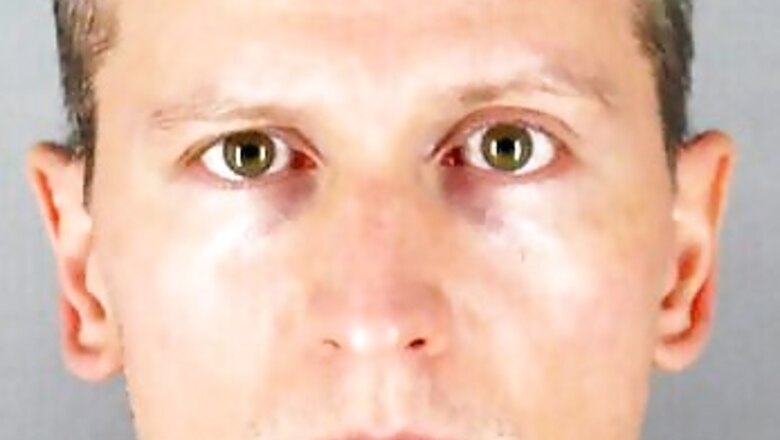
views
MINNEAPOLIS: As the trial approaches for a white Minneapolis police officer charged with murder in the death of George Floyd, prosecutors are putting the time Derek Chauvins knee was on the Black man’s neck at about nine minutes.
The time has fluctuated before. It was recorded as 8 minutes, 46 seconds in an initial criminal complaint a figure that became symbolic to many in the weeks after Floyds death before a math error was corrected to make it 7:46. But filings since then, citing time-stamped police body-camera video, now make it at least nine minutes.
The fact that the figure has evolved probably won’t matter at Chauvins trial, which begins Monday with jury selection. One former prosecutor says its common for such details to be fine-tuned as prosecutors build a case. A support group for victims of police violence says the discrepancies won’t have any impact.
He was obviously on there enough time to think about what he was doing. He heard the man pleading that he couldnt breathe, said Toshira Garraway, founder of Families Supporting Families Against Police Violence. If it was two minutes or if it was five minutes or if it was 10 minutes, he was fully aware Once he said, I cannot breathe he was supposed to remove his knee.
Floyd died May 25. He had been handcuffed and was pleading that he couldn’t breathe, but Chauvin kept his knee on Floyd’s neck even after he stopped moving and speaking.
Chauvin is charged with second-degree murder and manslaughter. Three other officers Thomas Lane, J. Kueng and Tou Thao are charged with aiding and abetting second-degree murder and manslaughter and are scheduled for trial in August.
The narrative in the initial complaint filed May 29 by the Hennepin County Attorneys Office says Chauvin held his knee to Floyds neck for 8 minutes, 46 seconds. But the time stamps cited in that charging document indicate it was actually 7 minutes, 46 seconds.
The Associated Press began asking about the error the day after the initial charges were filed, but prosecutors repeatedly declined to address it. The 8:46 detail was repeated in an amended complaint filed days later by the Attorney Generals Office.
In the weeks that followed Floyds death, some demonstrators staged die-ins that lasted 8 minutes, 46 seconds, some lawmakers knelt for that amount of time in the U.S. Senate, and mourners at a memorial service for Floyd stood in silence for 8:46 to reflect on the final moments of his life.
In mid-June, prosecutors acknowledged the one-minute error, but said it would have no impact on the case.
Documents filed by prosecutors in September and October changed the timing yet again. These documents contain the most detailed picture of what happened, citing time stamps from Lane, Keung and Thao’s body camera videos.
The documents dont list an exact time for when Chauvin began kneeling on Floyd, but instead provide a narrative for when Floyd was first pressed to the ground. Time stamps on video from Lanes body camera recorded in 24-hour-clock format show that began at some point from 20:19:14 to 20:19:45, meaning from 14 to 45 seconds after 8:19 p.m.
But the documents cite a clear moment when Chauvin removed his knee, when a stretcher was ready to take Floyd away. Lanes body camera time-stamp read 20:28:45.
This means Chauvin had his knee on Floyds neck for at least nine minutes flat, but possibly for as long as 9 minutes, 31 seconds. Documents filed by prosecutors characterize the timing as approximately nine minutes, though in at least one document it is characterized as more than nine minutes and twenty seconds.
Stiles, the spokesman for the Attorney Generals Office, said the length of time of Chauvins restraint will be evidence presented at trial. He declined further comment.
Tom Heffelfinger, a former U.S. attorney for Minnesota who is not connected to this case, said its normal for prosecutors to fine-tune details as they build a case and that the length of Chauvins restraint wont become essential until a prosecutor presents it to the jury.
But at trial, he said, the timing will become extremely relevant as both sides argue about Floyds cause of death. Heffelfinger also said it points to Chauvins state of mind and can be used by prosecutors to show willfulness, and that Chauvin had Floyd under his control and held his position for too long.
You can see from the bystander video, Chauvin had Floyd under control for that entire period, Heffelfinger said. He didnt need to have his knee to the neck in order to maintain that control.
___
Follow Amy Forliti on Twitter: http://www.twitter.com/amyforliti
___
Find APs full coverage of the death of George Floyd at: https://apnews.com/hub/death-of-george-floyd
Disclaimer: This post has been auto-published from an agency feed without any modifications to the text and has not been reviewed by an editor
Read all the Latest News, Breaking News and Coronavirus News here
















Comments
0 comment